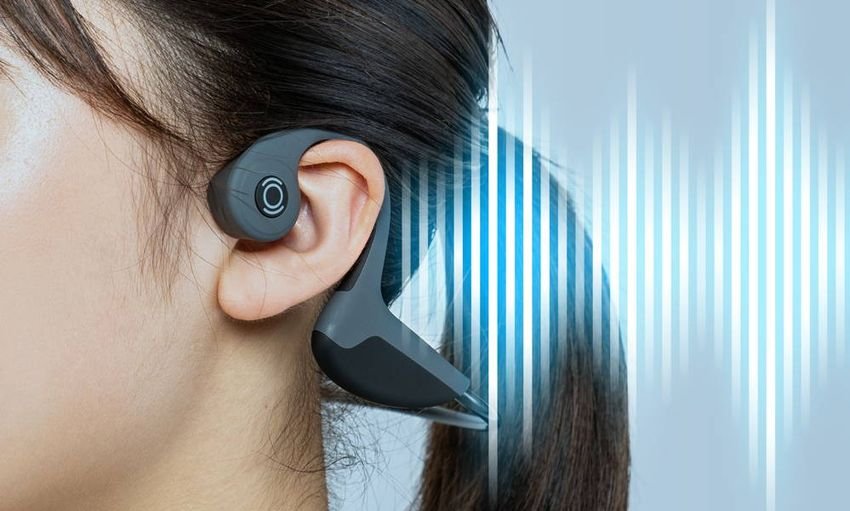If you've ever wanted to listen to music without losing the sound of your surroundings, it might be time to buy some bone conduction headphones.

Specialized bone conduction headphones lack speakers and allow your ears to hear outside noises, such as voices or oncoming cars. But it is not for everyone. They come with a few drawbacks, including sound quality. How do bone conduction headphones work and are they right for you?
How does bone conduction work?
Unlike regular headphones, bone conduction headphones do not rely on speakers that pulsate the air for creation audio. Instead, they use two transducers to vibrate your skull, or more specifically, your cheekbones.
These vibrations find their way to your headphone screw, where they translate into "sound" from your brain. Bone conduction effectively bypasses the eardrums of your ears, leaving them free to hear outside noises while you enjoy music, podcasts, phone calls or other sounds from your headphones.
Bone conduction is very different from air conduction, which is the process we usually mean when we talk about "hearing". With the conductivity of the air, the sounds create pressure waves in the air and this pressure vibrates the eardrums of your ears. The eardrums then vibrate your screw, which carries sound to your brain.
Some people think that bone conduction is "hard" or too shrill, and that's quite natural. When you speak, for example, you hear a combination of sound from the air and sound from your bones. That's why your voice sounds different when you hear it recorded. These recordings do not record the sound transmitted by the bones vibrating in your head. It's essentially how others actually hear you.
Benefits: Increased safety and awareness

Bone conduction headphones let the eardrums of your ears pick up any incoming sounds. Thus, the benefits are quite obvious, as you can use bone conduction headphones without excluding external noise.
To some, the headphones that let you hear your surroundings may be a little unorthodox. But depending on your responsibilities or hobbies, you may find yourself in a lot of situations where you need to be aware of your environment.
Cycling is probably the most popular use of bone conduction headphones. You need to know your surroundings while cycling on the road. Otherwise, you could be the victim (or cause) of an accident. A pair of regular headphones would block your environment while you are cycling, but the bone conduction headphones will allow you to hear oncoming cars or emergency vehicles.
Swimmers will also enjoy bone conduction headphones, which are often waterproof and sometimes work in salt water. In fact, some models of bone conduction headphones, such as the AfterShokz Xtrainerz for example, they work as portables Appliances MP3 player and eliminate the need to swim with your phone.
And because bone conduction headphones bypass your eardrum, they are a solid choice for people who wear earmuffs or hearing aids completely inside the ear. It is also a great alternative to traditional headphones if you have hearing loss outside or in your middle ear.
But be careful. Bone-in-the-ear headphones can damage your inner ear when at high volumes, just like regular headphones. And also they are not silent. The vibrations generated by these headphones produce an audible sound that other people can hear, especially if they are near you.
Of course, bone conduction headphones are not always needed in specific cases of use. For example, you could set up a barbecue and still want to hear your family's voices, or at least supervise your children.
The bad news: Sound quality and price

You should never buy bone conduction headphones for their sound quality. By nature, these headphones tend to focus on high and medium frequencies and lack any kind of bass. And because bone conduction headphones leave your ears open to external sounds, so you do not have an isolated hearing to enjoy music in all its glory.
That is, bone conduction headphones don't sound terrible. They can never match the quality of the best regular headphones. They carry it out work and if you mostly listen to podcasts or take phone calls, the sound quality honestly doesn't matter much in the first place. We should note that some bone conduction headphones come with earplugs, as plugging your ears actually improves the quality of bone conduction sound.
But there is another disadvantage to bone conduction headphones, the cost. Almost all bone conduction headphones start at € 30 and high quality models can cost several hundred euros. We realize that € 30 is not unreasonable, but it is a lot of money to spend on headphones that do not sound great.
Should You Use Bone Conduction Headphones?
The use of bone conduction headphones is a matter of preference. Are you willing to sacrifice sound quality to listen to your environment? Or, are you a swimmer who likes to listen to music while exercising? Then you are probably the right customer for a set of bone conduction headphones.
Of course, there are some situations where you absolutely should choose bone conduction headphones. Wearing traditional headphones or earphones while cycling, for example, is extremely dangerous. It is also illegal in some countries. We are not talking about a motorcycle that is banned by the bat.
Those obsessed with sound quality should leave bone conduction headphones off their shopping list. Alternatively, if you go to classic headphones you can see some alternatives solutions such as Sony LinkBuds and Bose Sport Open headphones, which feature an open design to allow you to listen to “some environment” without sacrificing sound quality.





